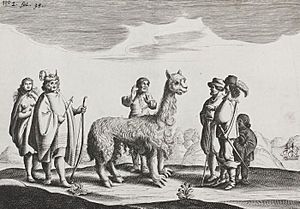Chilihueque facts for kids
The Chilihueque or Hueque was an animal like a llama or alpaca. It lived in central and south-central Chile a long time ago. This was before and during the time when Europeans first came to Chile. Scientists have different ideas about where the Chilihueque came from. Some think it was a wild guanaco that people tamed. Others believe it was a type of llama brought from northern areas. A study in 2016 looked at their mitochondrial DNA. It suggested that Chilihueques from Mocha Island might have come from wild guanacos in southern Chile.
Contents
Life and Uses of the Chilihueque
Working Animals
The Chilihueque was very useful to the native Mapuche people. A scientist named Juan Ignacio Molina wrote about them. He said that in 1614, a Dutch captain saw Mapuches using Chilihueques on Mocha Island. They used these animals to pull ploughs in their fields. This helped them prepare the land for planting crops.
Important Ceremonies
Chilihueques were also important in Mapuche traditions. Old Spanish records from the 1500s show this. The Mapuche used Chilihueques in special ceremonies. White Chilihueques were often preferred for these events. They were sometimes saved for important leaders.
Valued for Trade
These animals were also a main part of the "bride price" among the Mapuche. A bride price is a payment made by the groom's family to the bride's family. This shows how much the Chilihueque was valued in their society.
Why Did the Chilihueque Disappear?
Facing Competition
The number of Chilihueques began to drop in the 1500s and 1600s. This happened as European settlers brought new animals to Chile. Animals like sheep became more common. The Chilihueques had to compete with these new animals for food and land.
Replaced by New Animals
The exact reasons for their disappearance are not fully clear. However, we know that sheep became much more common than Chilihueques. By the late 1700s, very few Chilihueques were left. According to Tomás Guevara, only Mapuche people in certain areas still raised them. These areas were near Mariquina and Huequén, close to Angol. Eventually, the Chilihueque became extinct.



